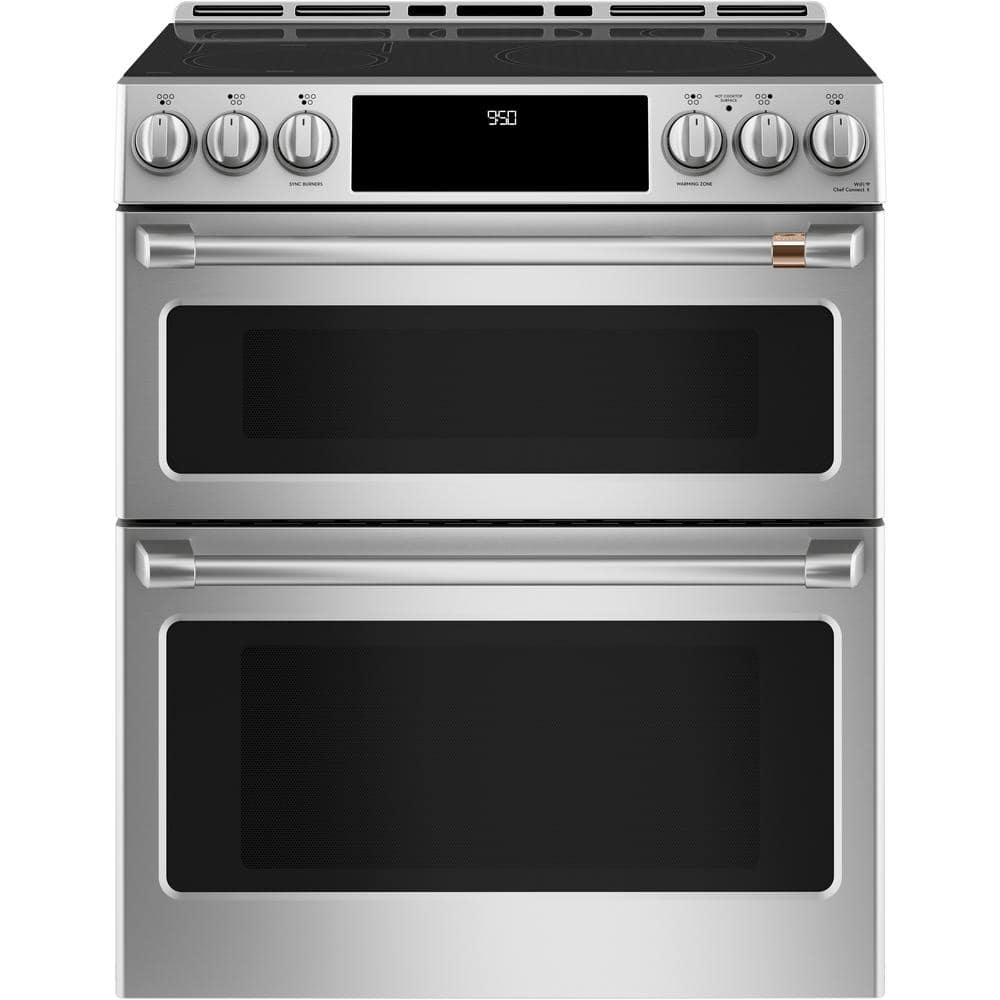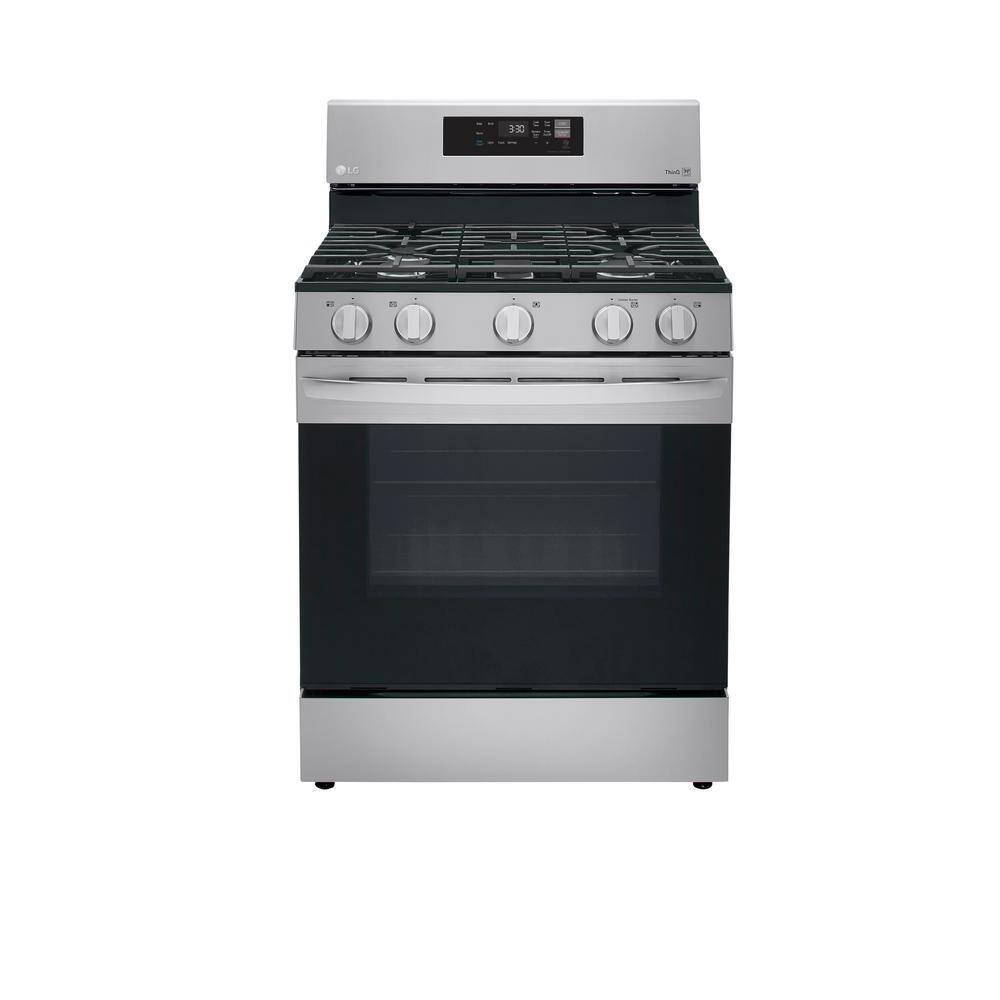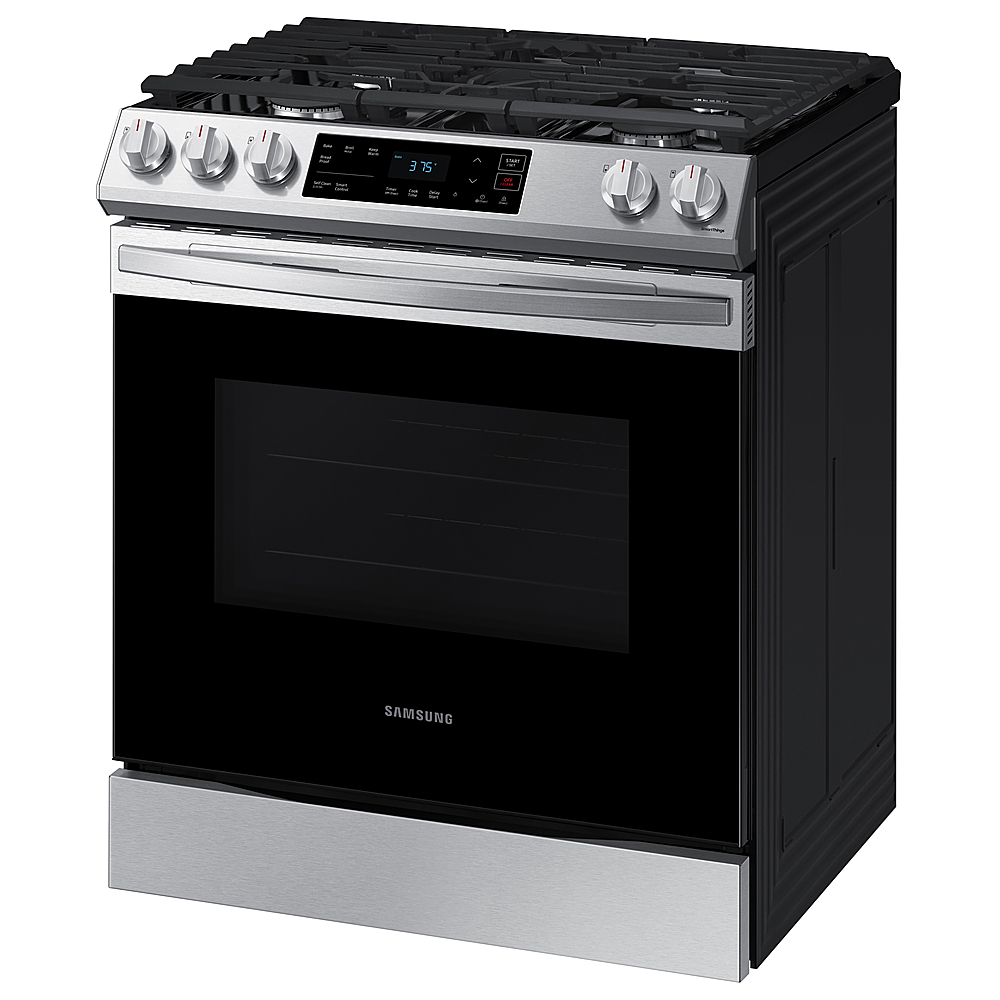Cafe 6.7 cu. ft. Smart Slide-In Double Oven Induction Range with Self-Cleaning and Convection Lower Oven in Stainless Steel
-
( 6 Reviews )Rated 4.83 out of 5 based on 6 customer ratings06
Gourmet guided cooking automatically adjust temperature and time. Wirelessly control oven functions from your smartphone. Edge-to-edge cooktop for cooking with pots and pans of all sizes.
-
GE 5.3 cu. ft. Slide-In Gas Range with Steam-Cleaning Oven in Stainless Steel
Rated 4.56 out of 509GE 5.3 cu. ft. Slide-In Gas Range with Steam-Cleaning Oven in Stainless Steel
Rated 4.56 out of 509
Nothing about your personal style is standard. So why should your appliances be? Created for those who want to reflect their true style in every room of their home, Cafe is distinct by design. Choose between two bold collections. The Customizable Professional Collection boasts a distinct line of hardware options, and the Modern Glass Collection features a seamless, contemporary design. Backed by showstopping features, every Cafe appliance gives you the form and the function you’ve been craving.
- Gourmet results without any guesswork – Take culinary skills to the next level with Gourmet Guided Cooking, which combines video-guided recipes from chefs with a system that automatically adjusts the time, temperature and cooking pace for perfect results
- An attractive appearance at all times – Every detail of your kitchen is designed to delight, thanks to a sleek backlit glass touch control panel that visually disappears when not in use and wakes up when prompted
- Create dinners and desserts at the exact same time – From everyday gourmet meals to large dinner parties, achieve impressive results with two independent ovens with a total capacity of 6.7 cu. ft. for true cooking flexibility, along with the accurate heat circulation of True European Convection with Precise Air in the lower oven
- The perfect combination of power and precision – Stun guests by showing off your 11 in. 3,700-Watt induction element, which uses chef-preferred induction cooktop technology to deliver precise heat to cookware only. That means you can do everything from boiling a quart of water in 101 seconds to melting butter at exact temperatures with amazing efficiency
- Precise control for flawless results – Delight guests with the precision of sous vide cooking or perfectly prepared fondues and delicate sauces using a precision cooking probe that is sold separately
- Enjoy total control in the kitchen and beyond – Control your oven with your smart device or simply your voice using WiFi Connect
- Create a look that matches your personal style – Select any combination of premium finishes and hardware options to create a stunning look customized to any owners taste
- Ensure consistent temperatures across a large area – Evenly heat large griddles or enamel cookware across two 8 in. synchronized elements
- Choose the range you want with total confidence – When you’re updating your kitchen, attention to detail is a priority. Thats why Cafe 30 slide-in ranges are guaranteed for an exact fit or Cafe Appliances will pay up to $300 toward modifications
- Limited 1-year entire appliance warranty
Additional information
| Depth With Door(s) Open 90 Degrees (In.) | 43.875 |
|---|---|
| Element No.1 Size (In.) | 11 |
| Element No.2 Size (In.) | 8 |
| Element No.3 Size (In.) | 6 |
| Element No.4 Size (In.) | 8 |
| Lower Oven Interior Depth (in) | 20.625 |
| Lower Oven Interior Height (in.) | 15 |
| Lower Oven Interior Width (in.) | 24 |
| Product Depth x Height x Width (in.) | 29.5 x 37.38 x 29.88 |
| Range Size (Width) | 30 |
| Upper Oven Interior Depth (in) | 19.125 |
| Upper Oven Interior Height (in.) | 10.125 |
| Upper Oven Interior Width (in.) | 2.4 |
| Certifications and Listings | ADA Compliant,UL Listed |
| Manufacturer Warranty | Limited 1-year entire appliance |
6 (six) is the natural number following 5 and preceding 7. It is a composite number and the smallest perfect number.
7 (seven) is the natural number following 6 and preceding 8. It is the only prime number preceding a cube.
As an early prime number in the series of positive integers, the number seven has greatly symbolic associations in religion, mythology, superstition and philosophy. The seven Classical planets resulted in seven being the number of days in a week. 7 is often considered lucky in Western culture and is often seen as highly symbolic. Unlike Western culture, in Vietnamese culture, the number seven is sometimes considered unlucky.
Cleaning is the process of removing unwanted substances, such as dirt, infectious agents, and other impurities, from an object or environment. Cleaning is often performed for aesthetic, hygienic, functional, safety, or environmental protection purposes. Cleaning occurs in many different contexts, and uses many different methods. Several occupations are devoted to cleaning.
Convection is single or multiphase fluid flow that occurs spontaneously due to the combined effects of material property heterogeneity and body forces on a fluid, most commonly density and gravity (see buoyancy). When the cause of the convection is unspecified, convection due to the effects of thermal expansion and buoyancy can be assumed. Convection may also take place in soft solids or mixtures where particles can flow.
Convective flow may be transient (such as when a multiphase mixture of oil and water separates) or steady state (see Convection cell). The convection may be due to gravitational, electromagnetic or fictitious body forces. Heat transfer by natural convection plays a role in the structure of Earth's atmosphere, its oceans, and its mantle. Discrete convective cells in the atmosphere can be identified by clouds, with stronger convection resulting in thunderstorms. Natural convection also plays a role in stellar physics. Convection is often categorised or described by the main effect causing the convective flow; for example, thermal convection.
Convection cannot take place in most solids because neither bulk current flows nor significant diffusion of matter can take place. Granular convection is a similar phenomenon in granular material instead of fluids. Advection is fluid motion created by velocity instead of thermal gradients. Convective heat transfer is the intentional use of convection as a method for heat transfer. Convection is a process in which heat is carried from place to place by the bulk movement of a fluid and gases.
Lower may refer to:
- Lower (surname)
- Lower Township, New Jersey
- Lower Receiver (firearms)
- Lower Wick Gloucestershire, England
An oven is a tool which is used to expose materials to a hot environment. Ovens contain a hollow chamber and provide a means of heating the chamber in a controlled way. In use since antiquity, they have been used to accomplish a wide variety of tasks requiring controlled heating. Because they are used for a variety of purposes, there are many different types of ovens. These types differ depending on their intended purpose and based upon how they generate heat.
Ovens are often used for cooking, where they can be used to heat food to a desired temperature. Ovens are also used in the manufacturing of ceramics and pottery; these ovens are sometimes referred to as kilns. Metallurgical furnaces are ovens used in the manufacturing of metals, while glass furnaces are ovens used to produce glass.
There are many methods by which different types of ovens produce heat. Some ovens heat materials using the combustion of a fuel, such as wood, coal, or natural gas, while many employ electricity. Microwave ovens heat materials by exposing them to microwave radiation while electric ovens and electric furnaces heat materials using resistive heating. Some ovens use forced convection, the movement of gases inside the heating chamber, to enhance the heating process, or, in some cases, to change the properties of the material being heated, such as in the Bessemer method of steel production.
In philosophy, the self is an individual's own being, knowledge, and values, and the relationship between these attributes.
The first-person perspective distinguishes selfhood from personal identity. Whereas "identity" is (literally) sameness and may involve categorization and labeling, selfhood implies a first-person perspective and suggests potential uniqueness. Conversely, "person" is used as a third-person reference. Personal identity can be impaired in late-stage Alzheimer's disease and in other neurodegenerative diseases. Finally, the self is distinguishable from "others". Including the distinction between sameness and otherness, the self versus other is a research topic in contemporary philosophy and contemporary phenomenology (see also psychological phenomenology), psychology, psychiatry, neurology, and neuroscience.
Although subjective experience is central to selfhood, the privacy of this experience is only one of many problems in the philosophy of self and scientific study of consciousness.
Stainless may refer to:
- Cleanliness, or the quality of being clean
- Stainless steel, a corrosion-resistant metal alloy
- Stainless Games, a British video game developer
- Stainless Broadcasting Company, a TV broadcaster based in Michigan, US
- Stainless Banner, the second national flag of the Confederate States of America
Steel is an alloy of iron and carbon with improved strength and fracture resistance compared to other forms of iron. Because of its high tensile strength and low cost, steel is one of the most commonly manufactured materials in the world. Steel is used in buildings, as concrete reinforcing rods, in bridges, infrastructure, tools, ships, trains, cars, bicycles, machines, electrical appliances, furniture, and weapons.
Iron is always the main element in steel, but many other elements may be present or added. Stainless steels, which are resistant to corrosion and oxidation, typically need an additional 11% chromium.
Iron is the base metal of steel. Depending on the temperature, it can take two crystalline forms (allotropic forms): body-centred cubic and face-centred cubic. The interaction of the allotropes of iron with the alloying elements, primarily carbon, gives steel and cast iron their range of unique properties. In pure iron, the crystal structure has relatively little resistance to the iron atoms slipping past one another, and so pure iron is quite ductile, or soft and easily formed. In steel, small amounts of carbon, other elements, and inclusions within the iron act as hardening agents that prevent the movement of dislocations.
The carbon in typical steel alloys may contribute up to 2.14% of its weight. Varying the amount of carbon and many other alloying elements, as well as controlling their chemical and physical makeup in the final steel (either as solute elements, or as precipitated phases), impedes the movement of the dislocations that make pure iron ductile, and thus controls and enhances its qualities. These qualities include the hardness, quenching behaviour, need for annealing, tempering behaviour, yield strength, and tensile strength of the resulting steel. The increase in steel's strength compared to pure iron is possible only by reducing iron's ductility.
Steel was produced in bloomery furnaces for thousands of years, but its large-scale, industrial use began only after more efficient production methods were devised in the 17th century, with the introduction of the blast furnace and production of crucible steel. This was followed by the Bessemer process in England in the mid-19th century, and then by the open-hearth furnace. With the invention of the Bessemer process, a new era of mass-produced steel began. Mild steel replaced wrought iron. The German states were the major steel producers in Europe in the 19th century. American steel production was centered in Pittsburgh, Bethlehem, Pennsylvania, and Cleveland until the late 20th century.
Further refinements in the process, such as basic oxygen steelmaking (BOS), largely replaced earlier methods by further lowering the cost of production and increasing the quality of the final product. Today more than 1.6 billion tons of steel is produced annually. Modern steel is generally identified by various grades defined by assorted standards organizations. The modern steel industry is one of the largest manufacturing industries in the world, but also one of the most energy and greenhouse gas emission intense industries, contributing 8% of global emissions. However, steel is also very reusable: it is one of the world's most-recycled materials, with a recycling rate of over 60% globally.
With or WITH may refer to:
- With, a preposition in English
- Carl Johannes With (1877–1923), Danish doctor and arachnologist
- With (character), a character in D. N. Angel
- With (novel), a novel by Donald Harrington
- With (album), a 2014 album by TVXQ
- With (EP), a 2021 EP by Nam Woo-hyun






by Ellie
This oven texts me more than my family or friends. It texts when I turn it on, when it preheats, when the timer goes off. If you are lonely, this is the oven for you. The oven works ok. The oven light button turns on both ovens lights, strange. You don’t get a manual. You have to download it and print. The manual isn’t for just my oven. For example, my oven has air fry mode but no mention of it in the manual. The biggest issue is when you turn the burners on, the knobs light up not the burner so you have a hard time keeping your pans centered. Oh the overall height of the oven is 36″ at it’s lowest. So my countertops are at 35.75. The oven sits higher than my countertops! Thank goodness my husband is crafty! He placed tile trim around the oven and it looks pretty good. Apparently the new glass tops don’t overhang because of breakage problems so the trim helps with that too
by Blue
Had to endure a longer than anticipated wait for my stainless steel Cafe induction range with double ovens (one of which is a convection oven), but I must say that I am beyond pleased. The unit has a very high end appearance and has very well thought out, useful features. Love the fact that when the range and the over the range microwave are set up on your home’s wi-fi network and Bluetooth, the range light will turn on when a burner knob has been turned on. Also, the nice white light around the burner knobs lights up when in use and will blink to let you know that you’ve selected the wrong burner (if a pot/pan is not placed on the burner that was turned on). Looking forward to purchasing a double burner griddle to make special breakfast meals a breeze. The range top includes a warm zone burner, a feature I’ve never seen before. I’ve only had this range for about a month, but I’m excited to learn and experience all that it has to offer, with many great meals to come. Thanksgiving gatherings immediately come to mind; the double range will come in extremely handy – as will the OTR microwave that has the capability of convection heating! If you’re on the fence, hop on over and submit an order of your new Cafe range. You’ll not be disappointed!
by Reggie
The oven keeps constant temperature which our profile did not. Also the induction is the way to go for safe chef-like cooking.
by Joe
We love this range. The induction cooktop is so fast, efficient, and steady. The double ovens are great, too – we LOVE having the air fryer option. We have small kids and we’re happy to report that there is a lock control feature. It’s nice that the oven and microwave sync… the light and vent turn on automatically when something is started on the stove. The oven is also beautiful and has improved the entire look of our kitchen. Couldn’t be happier with it!
by Steve
We’ve had the range a couple of months. We swapped from a defective gas range to this electric. We really like the flush top for its ease to clean. The induction top does a great job simmering. The convection oven easily cooks a roast chicken. We’re super pleased with this range.
by Moul
The stainless steel double oven range has a classic look to it and feels very solid. The doors have some heft to them and the knobs and handles feel solid. The induction works well. It boils water very fast! Just make sure the pots and pans you intend to use will work with induction. The lower oven has convection capability, so it can provide a quicker more even baking. Unfortunately, the smaller top oven doesn’t have the convection feature. It would have been nice if it did. The only other dislikes I have is the touchscreen is a bit too sensitive. You have to be careful if you accidentally touch the screen with your body (if you’re wiping down the exhaust fan, for example) as you may accidentally turn on the oven. Also, the knobs can turn too easily. I like to wipe down the knobs after cooking, but you need to be careful as you may turn on the range. But overall, a nice solid range that works well once you get use to cooking with induction.